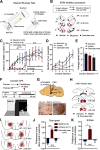Entopeduncular Nucleus Projections to the Lateral Habenula Contribute to Cocaine Avoidance
- PMID: 33214316
- PMCID: PMC7810656
- DOI: 10.1523/JNEUROSCI.0708-20.2020
Entopeduncular Nucleus Projections to the Lateral Habenula Contribute to Cocaine Avoidance
Abstract
The aversive properties associated with drugs of abuse influence both the development of addiction and relapse. Cocaine produces strong aversive effects after rewarding effects wear off, accompanied by increased firing in the lateral habenula (LHb) that contributes to downstream activation of the rostromedial tegmental nucleus (RMTg). However, the sources of this LHb activation are unknown, as the LHb receives many excitatory inputs whose contributions to cocaine aversion remain uncharacterized. Using cFos activation and in vivo electrophysiology in male rats, we demonstrated that the rostral entopeduncular nucleus (rEPN) was the most responsive region to cocaine among LHb afferents examined and that single cocaine infusions induced biphasic responses in rEPN neurons, with inhibition during cocaine's initial rewarding phase transitioning to excitation during cocaine's delayed aversive phase. Furthermore, rEPN lesions reduced cocaine-induced cFos activation by 2-fold in the LHb and by a smaller proportion in the RMTg, while inactivation of the rEPN or the rEPN-LHb pathway attenuated cocaine avoidance behaviors measured by an operant runway task and by conditioned place aversion (CPA). These data show an essential but not exclusive role of rEPN and its projections to the LHb in processing the aversive effects of cocaine, which could serve as a novel target for addiction vulnerability.SIGNIFICANCE STATEMENT Cocaine produces well-known rewarding effects but also strong aversive effects that influence addiction propensity, but whose mechanisms are poorly understood. We had previously reported that the lateral habenula (LHb) is activated by cocaine and contributes to cocaine's aversive effects, and the current findings show that the rostral entopeduncular nucleus (rEPN) is a major contributor to this LHb activation and to conditioned avoidance of cocaine. These findings show a critical, though not exclusive, rEPN role in cocaine's aversive effects, and shed light on the development of addiction.
Keywords: addiction; avoidance; cocaine; entopeduncular nucleus; lateral habenula; rostromedial tegmental nucleus.
Copyright © 2021 the authors.
Figures




References
-
- Booze RM, Lehner AF, Wallace DR, Welch MA, Mactutus CF (1997) Dose-response cocaine pharmacokinetics and metabolite profile following intravenous administration and arterial sampling in unanesthetized, freely moving male rats. Neurotoxicol Teratol 19:7–15. 10.1016/S0892-0362(96)00180-8 - DOI - PMC - PubMed
Publication types
MeSH terms
Substances
Grants and funding
LinkOut - more resources
Full Text Sources
Medical
